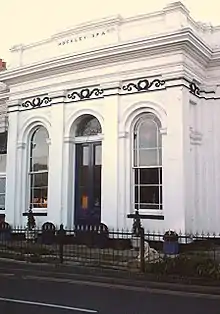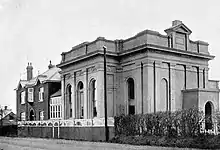Spa Pump Room, Hockley
The Spa Pump Room is a Grade II listed, early Victorian building in Hockley, Essex. It was built to the designs of James Lockyer in 1842 after a medicinal spring was discovered on the site four years earlier. The building closed as a pump room in the early 1850s and was used for other purposes, including a Baptist chapel, billiard hall, and a clothing factory; the pump room is now in private ownership.

History
Robert Clay and his wife, Letitia,[1] an ageing couple from Cheltenham, retired to Hockley in Essex, in 1838. The Clays, who had been users of Cheltenham's natural waters, rented a cottage and dug a water well in its garden. Letitia, a chronic asthmatic, found relief in drinking the water and declared it to be medicinal; they renamed their cottage Hockley Spa Lodge. In order to capitalise on their discovery, and to emulate the kind of success that spas in Bath and Royal Tunbridge Wells had achieved, they sought advice from a local businessman, William Summersall, who later became the manager of the spa, on how to build a pumping room to access larger amounts of water for the wider public.[2] The Clay's claimed that the water could heal asthma, indigestion, and infections of the liver, kidneys and bladder.[3] On Summersall's advice, they invited Dr. A. B Granville, an author who become notable for his many books on the medicinal properties of the world's natural spas, to test the water.[4] Granville was impressed and sent the samples to Sir Richard Phillips, a leading authority on natural consumables. It was Granville's mention of Hockley Spa in his book, The Spas of England, that brought Hockley's waters to national interest.[5]

The Clays appointed the London-based architect James Lockyer (1796–1875)[6] to design a pumping room. Lockyer instructed the Blackheath-based builder George Whittenbury, who was then architect to the Metropolitan Police, to execute his designs.[7] The building was completed in 1842.[8] Lockyer designed it in the Italian style. Inside, there was wainscot panelling with oak features. The tables were made of marble and rosewood and the walls had gold leaf detailing. The chimney pieces were marble. The pump was located in a circular recess opposite the landing and was made mostly of satinwood and glass. It was mounted on a veined marble table and had a yellow glass handle and silver spout. The foundation stone was laid at the back of the pump in the head of the recess.[9]
The Pump Room opened for business on 8 June 1843, a ticket only occasion[10] that was marked by a banquet meal for 150 of the town's gentry and their city acquaintances.[5] Despite Robert Clay's death in 1843,[11][n 1] the business flourished and the water became so much in demand that it was sent to a depot in Jewin Street, Cripplegate, London, where it was bottled and distributed to other countries.[3][13]
By 1848 the spa had fallen out of favour and the Pump Room, together with the Spa Hotel, was put up for sale and offered with a 99-year lease.[14] [15] The author and historian Phillis Embry, in her 1997 book British Spas from 1815 to the Present Day, records the Pump Room's use as a baptist chapel in 1857,[16] a function that lasted until at least 1871, noted that year in an article for the East London Observer.[17] By 1880 the pump room had been abandoned completely.[16] In 1896 The Essex Herald reported the attempts being made by a syndicate to recommission the well and to put the building back into use as a pump room.[18] The Pump Room was converted into a private billiard hall in 1904.[19] From 1947 the building was used as a clothing factory[16] before it fell into private ownership.[20] It was designated as a Grade II listed building in 1972.[8]
Associated buildings
There is c. 19th century, red brick house adjoining to the eastern side of the Pump Room.[8] The nearby Spa Hotel, also designed by Lockyer, is located on the crossroads of Southend Road, Main Road and Spa Road, and was used to accommodate the visitors who came to Hockley to use the spa's waters.[20][21]
Notes and references
Notes
- Robert Clay died aged 72 in 1843, shortly after the spa opened. He was buried on 5 August 1843 in the churchyard of St Peter and Paul, Hockley. His wife, Letitia, died in 1847 and was interred with him, on 18 February.[12]
References
- Benton, p. 297.
- Hembry, pp. 95–96.
- "Hockley Spa", The Morning Post, 2 May 1844, p. 8.
- "Hockley Spa Pump Room open", The Bury and Norwich Post, 14 Jun 1843, p. 2.
- "Hockley Spa Pump Room", The Essex County Standard, 16 Jun 1843, p. 2.
- The Pump Room, Hockley Spa, Essex: perspective view, RIBA archive, accessed 8 May 2019.
- "Greenwich Court of Requests", West Kent Guardian, 17 September 1842, p. 5.
- Historic England, "Hockley Spa Rooms (1112670)", National Heritage List for England, retrieved 2 October 2017
- "Hockley Spa Pump Room description", The Bristol Mercury and Daily Post, 1 Jul 1843, p. 7.
- "Tickets sold in London for Pump Room opening", The Times, 13 May 1843, p. 2.
- "Index entry". FreeBMD. ONS. Retrieved 2 January 2021.
- Burial register and Parish Records, Church of St Peter and St Paul, Hockley, Registers of Baptisms, Marriages and Burials 1813-1860, volume 1.
- "Hockley Spa Bottled Water 1843", London Age, 11 June 1843, p. 6.
- "Hockley Spa sale 1848", London Morning Post, 13 May 1848, p. 9.
- "Hockley Spa Tavern and Hotel", The Essex Herald, 16 May 1848, p. 1.
- Hembry, p. 96.
- "A ramble round Southend", East London Observer, 11 March 1871, p. 3.
- "Hockley Spa", The Essex Herald, 13 October 1896, p. 4.
- "A famous Essex spa", East London Advertiser, 8 October 1904, p. 2.
- Beattie and Pevsner, pp. 494–495.
- Hockley Parish Plan 2007, Rochford District Council, p.4, accessed 1 October 2017.
Sources
- Christie, Miller; Thresh, May (1910). The Mineral Waters and Medicinal Springs of Essex. London: Simpkin, Marshall & Co. ISBN 978-0-297-78142-4.
- Benton, Philip (1888). The History of Rochford Hundred. London: A. Harrington. ISBN 978-0-224-01288-1.
- Hembry, Phillis, May (1997). British Spas from 1815 to the Present: A Social History. London: Fairleigh Dickinson University Press. ISBN 978-1-6114-7153-3.
- Pevsner, Nikolaus; Beattie, James (2007). The Buildings of England: Essex. London: Yale University Press. ISBN 978-0-3001-1614-4.
External links
- Hockley Spa Pump Room, The Essex Field Club.
- The Pump Room, Hockley Spa, Essex, RIBA Archive.